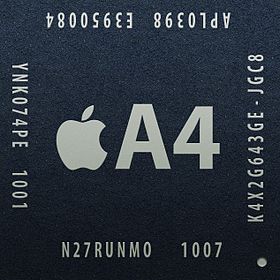 | |
| General information | |
|---|---|
| Launched | April 3, 2010 |
| Discontinued | September 10, 2013 |
| Designed by | Apple Inc. |
| Common manufacturer | |
| Product code | S5L8930X[1] |
| Performance | |
| Max. CPU clock rate | 800 MHz to 1 GHz |
| Cache | |
| L1 cache | 32 KB instruction + 32 KB data[2] |
| L2 cache | 512 KB[2] |
| Architecture and classification | |
| Application | Mobile |
| Technology node | 45 nm |
| Microarchitecture | ARM Cortex-A8 |
| Instruction set | ARMv7-A |
| Physical specifications | |
| Cores |
|
| GPU | PowerVR SGX535[3] |
| History | |
| Predecessor | Samsung S5L8920 |
| Successors | Apple A5 (iPhone) Apple A5X (iPad) |
The Apple A4 is a 32-bit package on package (PoP) system on a chip (SoC) designed by Apple Inc., part of the Apple silicon series, and manufactured by Samsung.[4][5] It was the first SoC Apple designed in-house. The first product to feature the A4 was the first-generation iPad, followed by the iPhone 4, fourth-generation iPod Touch, and second-generation Apple TV.[6]
The last operating system update Apple provided for a mobile device containing an A4 (iPhone 4) was iOS 7.1.2, which was released on June 30, 2014 as it was discontinued with the release of iOS 8 in September 2014.
The iPad (1st generation) was discontinued earlier than the iPhone 4 with the release of iOS 5.1.1 on May 7, 2012 because it only had 256 MB of RAM compared to 512 MB on the iPhone, and the fact that applications would crash more frequently with the graphics using a large portion of the RAM.
The last operating system update Apple provided for an Apple TV containing an A4 (second-generation Apple TV) was Apple TV Software 6.2.1, which was released on September 17, 2014.
- ^ "iOS 5.1 code hints at simultaneous A5X and A6 processor development". 27 February 2012. Archived from the original on 2012-05-02. Retrieved 2017-06-14.
- ^ a b Cheng, Jacqui (March 14, 2011). "Ars reviews the iPad 2: big performance gains in a slimmer package / The Apple A5". Ars Technica. Archived from the original on June 15, 2011. Retrieved July 13, 2011.
- ^ Klug, Brian; Lal Shimpi, Anand (June 30, 2010). "Apple's iPhone 4: Thoroughly Reviewed". AnandTech. Archived from the original on September 21, 2013. Retrieved September 20, 2013.
- ^ "Updated: Samsung fabs Apple A5 processor". EETimes.com. March 12, 2011. Archived from the original on 2013-05-09. Retrieved 2011-03-15.
The company conducted a cross-section analysis of the chip that revealed details indicating Samsung made the chip in its 45nm process, the same process and fab Apple used for its previous generation A4 SoC.
- ^ Clark, Don (2010-04-05). "Apple iPad Taps Familiar Component Suppliers - WSJ.com". Online.wsj.com. Archived from the original on 2018-09-19. Retrieved 2010-04-15.
- ^ "Apple Launches iPad" (Press release). Apple. 2010-01-27. Archived from the original on 30 January 2010. Retrieved 2010-01-28.